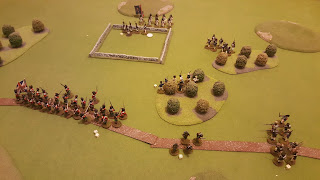A couple of months ago I finished rebasing and touching up my 1/72 scale Aztecs and Conquistadors but hasn't actually played a game with them. If come across the Lion Rampant variant "Quetzalcoatl Rampant" which can be found on the excellent I Live With Cats blog (Link) and decided these looked perfect for a test game.
I hadn't played Lion Rampant for ages but luckily Eric the Shed had arranged a Crusades themed game the week before and my son and I took part, fielding the Crusader forces. There's a report here on Eric's blog. Let's just say it didn't go well with the Crusaders failing practically every morale roll we made (and admittedly a flawed plan which the Saracens exploited fully). At least it meant that for the Aztec game I was fully up to date and familiar with the rules. Quetzalcoatl Rampant has a few variations. The Conquistadors have half strength units to reflect their low numbers but are significantly more powerful with better strength and defence and of course they have the benefit of horses and black powder weapons which can have a devastating effect on the Aztecs. The natives considerably outnumber the Spanish and have the option to capture rather than kill which also saps morale (presumably as the captives still-beating hearts are plucked out etc) although no one did this in our game.
We allocated sides randomly and my opponent, Anthony, took the Aztecs. We played a scenario where the Aztecs had to defend a sacred pyramid in the centre of the table with part of their force and hope remainder of their warriors arrived in time to repel the plundering Spanish. This was a large Lion Rampant game with 35 points per side. I find the activation rules for Lion rampant a bit disjointed...normally if a unit fails it's command roll then the whole side stops. At the games at Eric the Sheds the house rule is that even if an individual unit fails we continue for each one in a side. As a compromise I stuck with the normal LR rule but each of us had 2 commands...the Aztecs had the defenders and the relief force and the Spanish had the Conquistadors and some Tlaxcalan allies.
Initially things looked pretty difficult for the Aztecs. The Spanish steamed forward although their allies proved a lot less enthusiastic. The pyramid was defended by the elite Aztec Eagle and Jaguar knights but the relief force was also reluctant to hurry to their rescue.
The Spanish chased off some Aztec skirmishers with a pack of War Dogs but these in turn took heavy casualties as the key did so and being only 6 strong instead of the usual 12 this meant they couldn't take much punishment.
The Tlaxcalans fielded a unit of archers who proved pretty effective in weakening the Eagle Knights before being driven off the table as the Knights charged forward uncontrollably. They eventually came to grief themselves when the Spanish cavalry hit them. By this point the Aztecs relief force was beginning to but crucially most of Anthony's skirmish troops had lagged behind. Missile troops always seem powerful in LR and these may have made an impact if they'd got there in time. As it was the Spanish horse and Swordsmen were able to punch through the centre and seize the Pyramid, winning the game. What I hadn't realised (but Anthony had) was that I was only a unit away from my army morale breaking so the result was a very close run thing indeed.
The rule variants worked really well and although I'd initially been worried that the Spanish were overpowered the game was well balanced in the end. Many thanks to the I Live with Cats blog for a great adaptation.
 |
| The Spanish arrive |
 |
| Aztec skirmishers |
 |
| Woof!!..the Spanish War Dogs |
 |
| Aztec Knights defend the temple |
 |
| Aztec reinforcements arrive slowly |
















